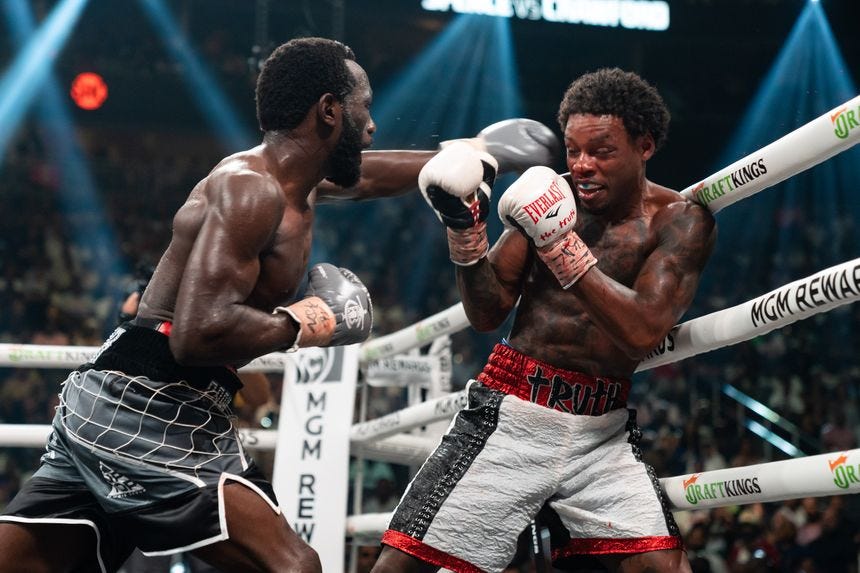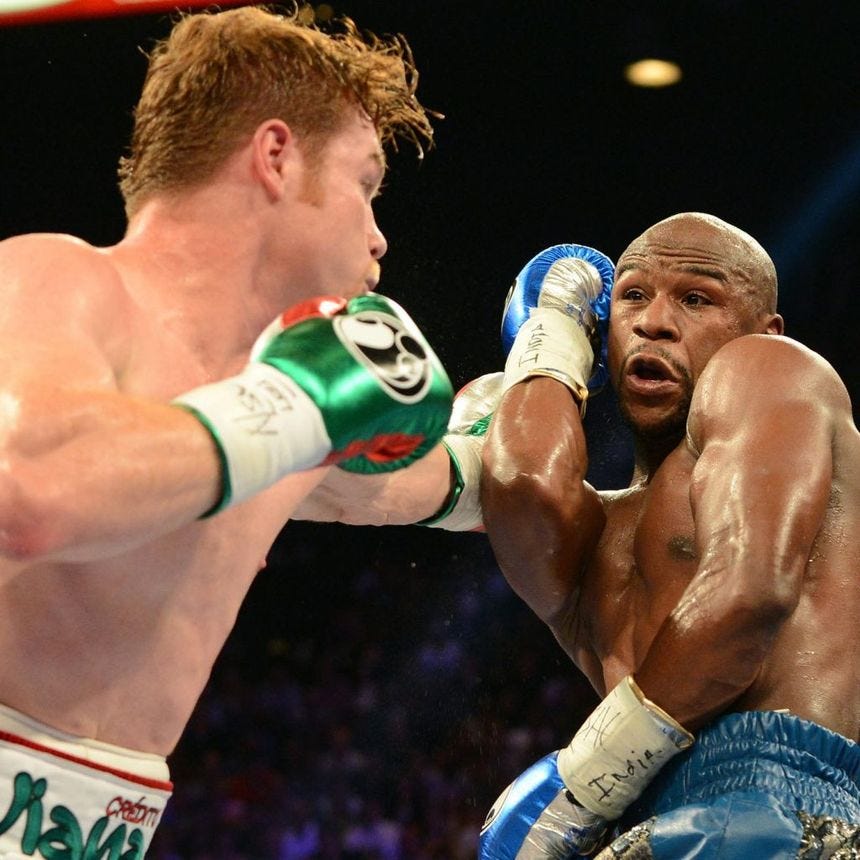Crawford's Masterclass
A New King is Crowned
I am certainly not the first to tell you how impressive Terence Crawford was. If I am, then go watch the fight. Right now. It is one of the most impressive performances I have seen live. Before the fight, pundits were touting this as an evenly matched fight. One between two-undefeated welterweight champions. The oft chased title unification fight in modern day boxing.
Crawford made sure that there was nothing disputed about who was the champion, and to many, the pound-for-pound number one fighter in the sport of boxing.
This performance was a 5-star, 7-course meal; there isn’t ONE thing that makes this performance great. A true harmony of tactics and techniques brought together to dismantle the insistent Spence. My favorites were:
· An adaptable jab
· Inside defense
· Frames
· Building upon counters
Lets dive in.
Disclaimer: The video clips included in this article are not owned by the author. They are included for educational purposes only to illustrate key moments in the fighter’s career and demonstrate aspects of mixed martial arts techniques and strategies. All rights to the video content belong to their respective owners.
Swiss-Army Jab
Crawford’s jab was the a perfect multi-tool. It was used to feint, damage, set up, and draw reactions with varied timing and placement. Out of every weapon in this fight, Crawford’s jab was by far his most versatile.
Just a piston.
In the first two rounds of the fight, Spence was the fighter with the more active jab.
Crawford was defending beautifully. Once he internalized the timing on Spence’s jab, he began jabbing with him. An important distinction to make is that they were not trading jabs. Crawford would jab at the same time as Spence, but his would knock Spence’s head back while he hit air.
Crawford begins by jabbing with Spence, and steals the initiative by immediately turning it into a triple jab, punishing his dip with the rear hand and punishing the body for good measure as his hands came up.
Crawford again steal the initiative throwing the dipping jab, hitting Spence clean. He can now counter Spence’s attempts to re-take the initiative. He also throws a lovely rear-hand lead into a jab that almost takes Spence off of his feet. This reminds me of Archie Moore’s “Left Cross”, where his jab had the power of a straight since his hips were loaded. Crawford throws his rear left, squaring his hips, allowing him to throw his own “Right Cross” (from the southpaw stance) at the end of this sequence.
One of Spence’s perceived strengths was on the inside. Though Crawford eventually showed he was the better there as well, the jab was an integral weapon in preventing Spence from pushing his advantage. Just as with his frames, Crawford put the jab out there to dissuade Spence from ever initiating the clinch of inside game in the first place.
After allowing Spence to bounce a couple of shots off of his guard, Crawford throws out 3 jabs just as Spence begins to initiate his own offensive sequences. Even when Spence does end up getting his offense going, its markedly different than it was a few seconds prior. Crawford’s jabs prevented him from being fully committed with his offense, and the added defense from Crawford’s Stonewall rendered Spence’s attempts flaccid.
Crawford beautifully switches between the jab and right hook as his lead hand attacks in this sequence. The jab is used to measure Spence’s distance on the outside, and keep him there by continuing combinations. When Spence does decide to move in (somewhat sloppily, as the jab is ever present on his mind), Crawford uses the right hook as a close range weapon to batter him through his high-guard bull-rush.
The real genius in his jab was its compounded use. If something is working, why not do it two, maybe even 3 times in a row? The double jab often worked to back Spence up and force him to move his head. Crawford anticipated and countered his head movement.
Just a gorgeous jab feint into a committed jab. While it landed, Spence rolled with it slightly, but Crawford was ready even for this as he attempted to punish Spence’s movement away from the jab with a rear hook.
Classic use of the double jab here. Get the opponent to move back with two non-committal jabs, and then sneak the right hand over the top. The rest of the sequence shows more of the jabs other uses: starting combinations, keeping Spence on the outside after a combination, and jabbing WITH Spence when he attempts to initiate his own offense.
Crawford’s triple jab often cemented his initiative when jabbing with Spence. Rather than jabbing once with him to let Spence know who’s jab was superior, he built on the lead to throw two more shots. In the sequence below, every single one lands clean. Spence’s hesitation is clear directly after this sequence.
Crawford uses a long triple jab here to punish Spence’s retreat. The first jab is again like a “Right Cross”, as his hips were squared from throwing the straight previously. The next two jabs act to keep offense on the retreating opponent and provide the opening for a left hook to the body. Jabs often keep the opponents guard up.
Crawford’s jab was SUCH a multi-faceted weapon this fight. If you want to learn how to optimize your jab, watch this fight a few more times and take notes.
Inside Stonewall
This was my favorite aspect of Crawford’s performance. Crawford’s most consistent choice to defend and counter on the inside was the Stonewall (Philly Shell, Shoulder Roll).
If you are unfamiliar, this was a style of defense and countering popularized in the modern era by Floyd Mayweather, but it has been around for quite a long time. It involves the lead hand covering the midsection which allows for jabs to come in from blind angles, and for the chin to be hidden behind the shoulder. The rear hand come up as a guard to the temple, and its high position also allows straight counters to be let loose. When paired with great eyes and head movement, it is an annoying weapon to deal with.
Early on in the fight (and in a few other instances), Crawford would throw up a traditional high guard which Spence could capitalize upon easier and throw punches through and around.
Crawford opts to keep his palm out while using the Stonewall to catch and paw Spence’s punches. As he retreats on an angle, he crashes into the clinch shoulder first to stifle Spence’s pressure. Spence is a wonderful body puncher in the clinch, but the simple lead hand draped across the midsection and elbow of the high guard prevented Spence’s body work from doing any real damage. When he saw an opening, Crawford opted to throw some hooks in.
Coming into this fight, most experts expected Spence to force the inside exchanges. After all, he showed a beautiful inside boxing performance against Ugas.
Crawford completely stifled him.
Crawford is able to anticipate the strike over the top, and as he circles off his rear elbow catches the body shot and he is able to quickly return with a counter.
Crawford’s Stonewall has multiple benefits. Having the arm across the body stifles potential body work from Spence, and keeping a guard on one side allows him to see the strikes coming (rather than blinding himself with the double forearms) and move while retaining some defensive responsibility.
Crawford’s Stonewall intercepts all of Spence’s body work as he shoots his own uppercuts between Spence’s offense. First to the body, and then to the head to stand Spence up and intercept him with a jab.
Crawford’s Stonewall puts his hands in the optimal position to transition between jabs, framing off of Spence, and throwing hooks over the top of his frames as Spence’s offense is stifled. Every tool of Crawford’s flows into another perfectly.
More importantly, it left his hands in optimal positions to counter (an additional benefit of keeping his eyes uncovered).
Crawford’s Stonewall again allows him to safely crash into the clinch, shoulder first and stifle Spence’s inside work. Once Crawford' takes the initiative on the inside, he is able to land clean uppercut as Spence falls forward attempting to get body work off.
Crawford beautifully mixes frames and jabs with his Stonewall, as well as ample head movement to further discourage Spence. Spence attempted to overwhelm Crawford with volume, which isn’t always a horrible idea. However, Crawford’s eyes and defensive reactions from the Stonewall on the inside put him in perfect positions to set up counter uppercuts and frames for hooks and jabs over the top.
Not only did Crawford never receive damage on the inside, he made Spence’s life miserable there.
Re-Framing the Narrative
Crawford’s use of the Stonewall was his key to defense on the inside, but it was his use of frames that set up his offense in that geography. As mentioned in the previous section, Crawford was able to frame off of his Stonewall for offense, measuring distance, and keeping Spence from initiating his own offense on the inside.
Crawford isolates one arm to clinch on his terms and then use a small frame to keep a safe distance.
In a sport where clinching acts as a break in the action, boxers need to know how to prevent the clinch from happening. In modern day boxing, many tired or hurt fighters can simply grab on to their opponents and receive a brief respite. From initiation, to control, to referee break, to resuming the action, you can get at least 10 seconds to recompose. Many referees are also hesitant to let boxers work in the clinch, (I see you, Kenny Bayless), preventing a Duran-esque inside game from being utilized at the highest level.
Crawfords frames allow him to track and control Spence’s head position. By the end of the sequence, Crawford completely controls Spence’s posture as he attempts to clinch.
Where most boxers simply let the clinch occur, Crawford refused to let Spence charge in. Crawford frequently posted his forearm on Spence’s neck or head to control his posture and keep him out of the inside game.
Crawford’s frames accomplish the same purpose of preventing Spence from entering the clinch. This plays well with his jab, in what Connor Ruebusch calls a “Sticky Jab”, where the jab is left out rather than retracting, maintaining a frame for Crawford to control Spence’s head.
A frame also acts as a distance measuring tool, and Crawford was able to throw a hard punch on an un-moving Spence a few times throughout the course of their bout.
The other reason framing like this works?
It’s just fucking annoying. Times when Spence tried to step on the inside or initiate a clinch, Crawford could throw his forearm right on his head, and he cannot do anything about it. It feels like the bigger kid holding his hand on your head as you try to rush in. When you’re trying to salvage a breath or bring the fight into your desired geography, nothing is more enraging than a simple arm preventing you from doing anything.
Moments in the second & fifth round encapsulate every weapon discussed well.
The Beauty of a Counter
Crawford was able to counter every piece of significant offense Spence attempted to offer this fight. He had answers to every single one of Spence’s questions.
While the first round was quite slow from both men, the knockdown in the second completely changed the momentum of the fight. While the body jab can be a good move to keep distance and wear down the opponent (a favorite of Floyd), Crawford was able to block it and throw his rear hand over the top. I have seen this counter many times and it might glance or do a good bit of damage.
In this instance, Crawford had his hips loaded and swung them into a jab, which was more like a straight that sent Spence to the canvas. You can see when you slowly scrub through the video that Crawford is much more square to Spence (body facing) while Spence is more side on. This allowed the jab to come out like a piston and ding the retreating opponent. This is the “Right Cross” referenced earlier.
The great thing about Crawford is this counter was not a case of one and done. When Spence attempted to body jab again in the third, Crawford threw the same exact counter. Though it didn’t knock him down this time, it let Spence know that the body jab would no longer be a weapon he could reliably fall back on. Rather than assuming that they will stop altogether, Crawford remembers his reads, and reminds the opponent that if he was able to touch you, he will do it again.
Crawford continued to wear on Spence throughout the middle rounds, dominating just about every exchange. Spence did have a moment in the fifth where he landed *one* good shot. Crawford was unfazed and controlled Spence’s posture while digging in a gorgeous uppercut to the body. Even in one of Spence’s sole moment of success in the fight, Crawford still had an answer.
The fight could have been stopped after the seventh. After using the Stonewall on the inside to defend against a rush by Spence, Crawford backs himself onto the ropes and baits Spence to come in. Spence throws a body jab into a HUGE overhand right, which connects. When watching live, I could only vaguely surmise that Spence had been hit with an uppercut. When I saw the replay, I was blown away. A short, powerful uppercut, slightly helped by Crawford bouncing off of the ropes, that connects just before Spence’s overhand right. It reminds me of the uppercut Jersey Joe Walcott knocked out Ezzard Charles with in their third bout. It is one of the most gorgeous knockouts of all time, and the ease and angle at which Crawford throws this uppercut are reminiscent.
Now sit there and tell me Jersey Joe ain’t a legend. Knocks Charles out while taking a Sunday stroll through the park.
Later in the round, Crawford secures another knockdown with two lead hooks that counter Spence’s level changes after he jabs. At this point he is anticipating just about everything Spence is doing.
After taking some time off in the eight round to let Spence come to him, he finally does. After attempting another overhand, Spence is struck with Crawford’s lead hook immediately followed up by a jab. Every punch following simply secures the finish in a fight that Spence was out of since the previous round. A courageous effort by Spence, but a masterclass in jabbing, defense, and counters by Terence Crawford.
Other Cool Moments
The rear straight into “Right Cross” is brought back, but instead of leaving it as is, Crawford follows up with another rear hand over the top.
The double jab to rear hand flows perfectly into a frame that Crawford uses to let off some hellacious body shots. All of Crawford’s punches look so impactful, and have such intent. Gorgeous.
The shot selection here is just absolutely gorgeous. Jab —> hook —> uppercut to the chest, all while avoiding Spence’s offense.
Crawford consistently chose the best weapons to punish Spence’s lateral movement. Lovely little pivot at the end as well after a slappy upper.
I am thrilled to have finally become a fan of both men, but especially Terence Crawford. I will be tuning in to every subsequent fight of his, and I hope he can continue his prime for at least another year or two (hopefully more).
A study in someone who has mastered the fundamentals (a beautiful jab and savvy defense), paired with an innate sense of timing and finding a counter mid-fight; Crawford is a boxer few can emulate. Study him regardless as there’s an endless amount to learn. Crawford truly is a special fighter who I would love to see build his legacy further.






